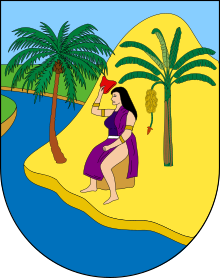Coat of arms of Antioquia Department
| Coat of arms of Antioquia | |
|---|---|
 |
|
| Details | |
| Armiger | The Department of Antioquia. |
| Adopted | August 23, 1812 |
| Escutcheon | A matron dressed and adorned Indian, seated between the plantain and the palm, and reclining at the foot of a hill Or, with a rushing river at her feet, uncapping in the most graceful attitude a phrygian cap. |
| Use | Gubernatorial Flag, official documents, medal. |
| Escudo de Antioquia | |
|---|---|
| Awarded by the Department of Antioquia | |
| Country | Colombia |
| Type | Triple-grade Medal |
| Status | Active |
| Description | A golden medal with the coat of arms of Antioquia inscribed and a ribbon in green and white, the colours of the flag of Antioquia. |
| Precedence | |
| Next (lower) | Star of Antioquia |
The coat of arms of Antioquia, in its current form, dates back to August 23, 1812 when it was officially adopted by the Chamber of the Senate of Antioquia by means of Decree 21 of 1812, replacing the Great State Seal of Antioquia that was sanctioned by State President José María Montoya Duque on September 2, 1811. Following the incorporation of Antioquia to the United Provinces of New Granada and subsequently to the Granadine Confederation and the United States of Colombia, the Sovereign State of Antioquia adopted the coat of arms of Colombia as its state arms. Antioquia reverted to the original coat of arms in 1912 for the occasion of the centenary of the independence of Antioquia and it has been in official use ever since.
The coat of arms as is seen today follows the blazon ordered in 1812:
That the State take for arms in its public escutcheons and in the great seal of the Dispatch of business, a matron dressed and adorned Indian, seated between the plantain and the palm, and reclining at the foot of a hill Or, with a rushing river at her feet, uncapping in the most graceful attitude a phrygian cap.
The rulers wanted not only to record the autonomy of the New State, but they wanted to symbolize its wealth and virtue with the golden hill, its triumphs and victories with the palm, its abundance with the plantain tree, its freedom with the phrygian cap, and the whole Antioquian race with the matron.
Although the coat of arms was adopted and blazoned in 1812, the coat of arms would only take form until 1912 when it was officially recreated for the occasion of the centenary of the independence of Antioquia by orders of the historian José María Mesa Jaramillo and executed by Daniel Mesa, and curiously enough, the model used to draw the matron who is supposed to represent the Antioquian population, was a Mexican actress named Virginia Fábregas. The coat of arms is currently used as a symbol of the state and is displayed at departmental buildings and offices, issued in official documentation, cast into a medal awarded by the department, and used in conjunction with the civilian flag of Antioquia to form the Governor's flag.
...
Wikipedia
